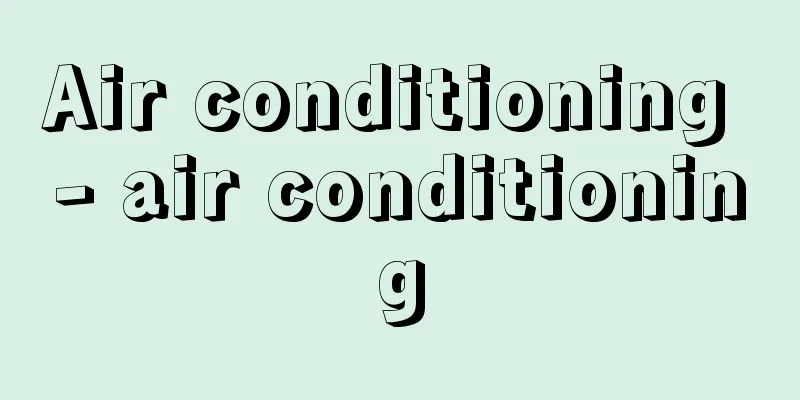Air conditioning - air conditioning

|
It is a process of simultaneously adjusting the temperature, humidity, purification and airflow of air to meet the needs of the room. It is called air conditioning, or air conditioning for short, or air conditioning for short. This means heating and cooling throughout the year, and heating alone is not called air conditioning. [Toshio Terai] historyThere are records of Roman Emperor Elagabalus making mountains of snow in his garden in summer to obtain coolness, of Egypt obtaining cold water by evaporating water, and of India obtaining ice by dissolving saltpeter in water to create low temperatures, but it was American doctor John Gorrie who actually used a refrigerator to provide air conditioning (1845). He patented a gas refrigerator (compressing air to 2 atmospheres, cooling it, and then expanding it with an expander to obtain a low temperature of -7°C), which he used to make ice and cool hospital rooms. In 1894, the German company Linde released an air conditioning system that had an ammonia refrigerator in the basement and an evaporator in the attic. Air conditioners came into widespread use with the advent of motor-driven fans and the use of less toxic refrigerants (dichloroethylene and dichloromethane). In the United States, in 1902, W. H. Carrier planned an air conditioner for a printing factory in Brooklyn, where he performed full-scale temperature and humidity control, and used an air purifier (which sprays water to transfer heat and water vapor between the air and the water droplets) to cool and dehumidify or humidify the air. He later published a fundamental paper on the equation of change in state of moist air, laying the theoretical foundation for air conditioning technology. The psychrometric chart based on his theory plots the saturation curve and wet-bulb temperature on an orthogonal coordinate system with the air temperature and absolute humidity as axes. Currently, the oblique coordinate diagram with the enthalpy (total heat content) and absolute humidity of air, invented by Mollier, is widely used. Turbo compressors were first used in air conditioning by Carrer in 1921, and with the emergence of fluorocarbon-based refrigerants in 1930, they became widely used in large-capacity refrigeration units, and are now installed in most large buildings. The absorption refrigerator was invented by F. Carré in 1859, but absorption refrigerators using water and lithium bromide were developed in the United States after World War II. The principle of the heat pump was discovered by Lord Kelvin of England in 1852. The first heat pump was used for heating in the United States in 1927, and today it is widely used for air conditioning in ordinary homes. It is said that the beginning of air conditioning in Japan was in 1907 (Meiji 40), when air conditioning equipment was imported from the United States and installed in a spinning factory. [Toshio Terai] ApplicationsThere are two types of air conditioning: health air conditioning, which aims to make people comfortable, and industrial air conditioning, which aims to improve work efficiency and product quality in factories. As the scale of buildings becomes larger, the number of buildings that cannot be used without air conditioning is increasing, and air conditioning has become an indispensable facility for buildings. The human body's thermal sensation is determined by four elements: air temperature, humidity, airflow, and radiation, and health air conditioning is intended to keep these within a comfortable range. Air cleanliness is expressed by the number of dust particles and the carbon dioxide concentration as an indicator of pollution. In air conditioning, air purification is usually achieved by diluting polluted indoor air by taking in outside air and removing dust with filters. In some cases, odors may be removed with activated charcoal and sterilization may be achieved with germicidal lamps. Industrial air conditioning may require extremely high-level control of temperature, humidity, and cleanliness depending on the conditions required for quality control of the target product and the type of work. In high-temperature factories, spot cooling (localized cool air blowing) may be used, or only the operator's room (booth) may be air-conditioned. In particular, high-efficiency particulate air filters (HEPA) have recently become available, making dust removal easy, and some integrated circuit manufacturing factories and bio-clean rooms require Class 10 cleanliness (meaning 10 or fewer particles of 0.5 micrometers or more per cubic foot). In addition, the temperature and humidity conditions for the product may not be suitable for the thermal environment of the human body, which can cause physical illness. [Toshio Terai] ZoningIn the perimeter zone, which is adjacent to the exterior walls and roof of a building, the amount of heat entering or leaving the building changes depending on the direction and time of day, because the outside temperature and solar radiation change. On the other hand, in the center of the building (interior zone), these effects do not affect the heat generated throughout the year. In order to maintain the desired room temperature, the perimeter zone needs to be cooled in summer and heated in winter. In some cases, cooling may be necessary even in winter if the solar radiation is high. On the other hand, the interior zone needs to be cooled throughout the year. The amount of heat added or removed at this time is called the thermal load. Therefore, buildings are divided according to their direction (east-west, north-south, top floor, etc.), the purpose of the room (executive room, office, meeting room, dining room, etc.), and the time of day (zoning), and it becomes necessary to control the air conditioning according to the heat load of each zone, or to install separate air conditioning equipment. The building design also requires sufficient insulation in the top floor and rooms at both ends to ensure that they are not thermally disadvantaged compared to the center. [Toshio Terai] Air conditionerAn air conditioner consists of an air filter to remove dust from the air, two types of heat exchangers (called a heating coil and a cooling coil) for heating and cooling/dehumidifying, a humidifier, and a blower. In some cases, a coil that serves both preheating and precooling is also added. In the past, air purifiers were used instead of cooling coils and humidifiers. Air purifiers are essentially heat exchangers, and are not very effective at removing dust from the air. Air conditioners are assembled in a factory and then installed, with electricity, hot and cold water piping, and ducts connected. Outside air and recirculated air are led into the air conditioner, mixed and dust-removed, then cooled and dehumidified in the case of cooling (the heating coil and humidifier are not working), or heated and humidified in the case of heating (the cooling and dehumidification coil is not working), and sent out to the duct. If the air entering the air conditioner is highly humid, the temperature of the water sent to the cooling coil is lowered to increase the condensation of water on the coil surface. As a result, the air temperature drops more than necessary, so even in the case of cooling, it may be necessary to heat the air with a heating coil (called reheating). Generally, hot or cold water is passed through the coil, but in small cooling and dehumidification coils, the evaporator of the refrigerator may be used as the cooler (also called a direct expansion type, since the refrigerant vaporizes and expands directly inside the cooler). A heating coil that uses steam is also used. [Toshio Terai] Air conditioning methodThe constant air volume single duct system is the most basic air conditioning system, in which hot and cold air is sent from the air conditioner through a duct to each room. The air volume and its air condition are adjusted so that the desired air condition in the room is achieved when the heat and moisture generated in the room is absorbed by the air being sent. It is widely used in interior zones where the load does not change much. The air conditioner and the associated heat source equipment are installed in the underground machine room, and air is sent to each floor through a vertical duct, sent to each room through a horizontal duct, and blown out from the air outlet. The air in the room is returned to the air conditioner again through the intake and return duct. Outside air is taken in as needed to keep the air clean, but for heat economy, only the amount of return air equal to the amount of outside air taken in is exhausted, and the rest is mixed with the taken in outside air and recirculated for use. Recirculation may not be performed during the intermediate period between summer and winter. Outside air intakes and exhausts are installed on the exterior wall or roof of the building. Only exhaust is ventilated from parking lots, machine rooms, toilets, water heaters, etc. to prevent contaminated air from leaking elsewhere. A system that adjusts the volume of air sent according to the thermal load of a room to increase economy is called a variable air volume system. If there are several zones, each zone is controlled by a variable air volume unit. Since the maximum load of each zone generally differs over time, it is possible to create an efficient system, and this system is widely used as an energy-saving design. In the double duct system, hot and cold air is sent through two ducts, and then mixed appropriately according to the load of the room. Since hot and cold air are mixed, there is a lot of heat loss due to the mixing, so this system has not been installed much since energy conservation became a consideration. In large offices with a great depth, fan coil units or induction units are placed in the perimeter zone so that this system can handle load fluctuations, while the interior zone is often equipped with a constant air volume single duct system. A fan coil unit has a fan, hot and cold water coils and an air filter inside the casing; the fan circulates the air, and hot and cold water is piped to the coil, which is switched appropriately to heat or cool. Securing outside air must be considered separately. An induction unit has an air blow-out nozzle, coil and air filter inside the casing, and outside air is processed by a central air conditioner and sent to the unit through a high-pressure duct, where it induces room air when it is blown out through the nozzle to create an airflow, and hot and cold water is piped to the coil. Compared to a fan coil unit, it is characterized by the supply of outside air and the flexibility of room temperature control depending on the amount of air supplied. When the hot and cold water each have their own supply pipe and return pipe (requiring four pipes, this is called a four-pipe system), there is no heat loss due to mixing of hot and cold water in the return pipe compared to when a common return pipe is used (called a three-pipe system), which is advantageous in terms of energy conservation and has come to be used. [Toshio Terai] Heat source equipmentDuring heating, gas or heavy oil is generally burned in a boiler to obtain steam, which is then heated in a heat exchanger and sent to air conditioners and fan coil units. During cooling, a refrigerator is operated. Even in summer, steam is generated, and when there is room, an absorption refrigerator that uses steam as a heat source may be used. In the refrigerator, cold water is produced in an evaporator and sent to air conditioners and fan coil units. Cooling water is passed through the condenser to remove the heat released from the condenser, and the heated cooling water is cooled in a cooling tower installed on the roof. Some systems combine a boiler and an absorption refrigerator to produce hot and cold water at the same time, and some package types incorporate a heat source and an air conditioner. A cooling tower works in the same way as an air purifier, with a water tank at the bottom and a blower to blow outside air through it. There is a filling inside, and water sprayed from the top of the cooling tower flows down the surface of the filling inside the tower, exchanging heat with the air flowing from bottom to top. The water can theoretically be cooled to the wet bulb temperature of the air. [Toshio Terai] Efficient use of energyIn countries like Japan where energy sources are scarce, it is necessary to use energy efficiently, and in 1979 the "Law Concerning the Rational Use of Energy" (Law No. 49 of 1979) was enacted, imposing two constraints on buildings: reducing the heat load from the perimeter zone and increasing the efficiency of air-conditioning equipment. For the former, buildings must be designed so that the annual load on the perimeter is below a certain value. For air-conditioning equipment, the overall thermal efficiency must be increased by reducing the amount of outside air taken in, recovering exhaust heat, and adopting systems with high thermal efficiency. There are also attempts to increase energy efficiency by generating electricity in-house and using the exhaust heat for air-conditioning. Since most heat inside a building is generated by lighting, consideration must also be given to lighting fixtures and their flickering. [Toshio Terai] [Reference] | |Source: Shogakukan Encyclopedia Nipponica About Encyclopedia Nipponica Information | Legend |
|
室内の要求を満たすように、空気の温度、湿度、清浄および気流を同時に処理する過程をいう。エアコンディショニング、略してエアコン、あるいは空気調整、略して空調という。これは年間を通じて暖冷房を行うことが意味され、暖房だけでは空調とはいわない。 [寺井俊夫] 歴史冷たさを得るためにローマ皇帝エラガバルスが夏期に庭に雪の山をつくらせたり、エジプトで水の蒸発により冷水を得たことや、インドで水に硝石を溶かし低温をつくり氷を得たことが記録にあるが、冷凍機を用い実際に空調を行ったのは、アメリカの医師ゴリーJohn Gorrieである(1845)。彼は気体冷凍機(空気を2気圧に圧縮し、冷却したのち膨張機で膨張させて零下7℃の低温を得ている)の特許をとり、氷の製造と病室の冷房とを行っている。1894年ドイツのリンデ社は、アンモニア冷凍機を地下に、屋根裏部屋に蒸発器を設ける方式の冷房装置を発売している。 空調装置が広く利用されるようになったのは、モーター駆動ファンの出現や、毒性の少ない冷媒(ジクロロエチレンおよびジクロロメタン)が用いられてからである。アメリカでは1902年にキャリアW. H. Carrierが、ブルックリンの印刷工場の空調装置を計画して本格的な温湿度制御を行い、空気洗浄機(水を噴霧し空気と水滴との間で熱および水蒸気の移動を行わせる)で空気の冷却除湿または加湿を行った。彼はその後、湿り空気の状態変化式に関する基本的な論文を発表し、空調技術の理論的基礎をつくった。彼の理論に基づく空気線図は、気温と空気の絶対湿度を軸とする直交座標上に飽和曲線と湿球温度を記入したものである。現在はモリエMollierの考案になる、空気のエンタルピー(全熱量)と絶対湿度を軸とする斜交座標の図表が広く用いられている。 ターボコンプレッサーは1921年にキャリアにより初めて空調に使用され、1930年にフロン系の冷媒の出現とともに大容量の冷凍機に広く利用され、現在大建築のほとんどに設備されている。吸収冷凍機は1859年カレF. Carréにより考案されたが、水と臭化リチウムを用いる吸収冷凍機は第二次世界大戦後のアメリカで発達した。ヒートポンプの原理は1852年イギリスのケルビン卿により発見された。1927年にアメリカで最初のヒートポンプによる暖房が行われ、現在では一般の家庭でも広く空調に利用されている。日本では1907年(明治40)にアメリカから空調装置が輸入され紡績工場に設置されたのが空調の始まりであるといわれる。 [寺井俊夫] 用途空調には、人間の快適さを目的とする保健用空調と、工場での作業能率や製品の品質向上を目的とする産業用空調とがある。建築の規模が大となるにつれ、空調なしではとうてい使用できない建物が増加してきており、建物に不可欠の設備となってきている。 人体の温熱感覚は空気の温度、湿度、気流および放射の4要素により決まり、保健用空調はこれらを快適な範囲に保つためのものである。空気の清浄さは塵埃(じんあい)個数や、汚染の指標としての炭酸ガス濃度により表される。空調においては、空気の清浄は外気の取り入れによる室内汚染空気の希釈と、フィルターによる塵埃の除去という形で行われるのが普通である。場合により活性炭による臭気の除去、殺菌灯による殺菌などが行われることもある。 産業用空調は、対象となる製品の品質管理上必要な条件や作業の種類により、温度、湿度、清浄度それぞれに対しきわめて高度な制御を要求される場合がある。また高温工場などではスポットクーリング(局所冷風吹出し)を行ったり、操作員室(ブース)だけを空調する場合もある。とくに最近では高性能粒子エアフィルター(HEPA)ができ、除塵が容易に行えるようになり、集積回路の製造工場、バイオクリーンルームなどでは、クラス10(0.5マイクロメートル以上の粒子数が1立方フィート中10個以下をいう)の清浄度を要求されるものも現れている。また、製品に対する温湿度条件が人体の熱環境として適当でない場合もあり、体調を崩す例もある。 [寺井俊夫] ゾーニング建築の外壁、屋根などに接する、外周部(ペリメーターゾーンperimeter zoneという)では外気温や日射が変わるため、建物への流入または建物から流出する熱量もその方位や時間により変わる。一方、建物中央部(インテリアゾーンinterior zoneという)では、それらの影響が及ばず一年中変化のない発熱がある。室温を希望する状態に保つためペリメーターゾーンでは、夏は冷房を、冬は暖房をする必要がある。場合によっては冬でも日射が大きいと冷房する必要があることもおこる。一方、インテリアゾーンでは1年を通じて冷房をしなければならない。このとき加除する熱量を熱負荷という。したがって、建物は、その方位(東西南北面、最上階など)、室の使用目的(役員室、事務室、集会室、食堂など)、時間帯に応じて区分し(ゾーニングzoningという)、それぞれのゾーンの熱負荷に応じて空調の制御を行うか、別個の空調装置を設ける必要が生ずる。建物の設計も、最上階、両端部の室などでは十分な断熱を行い、中央部に比べて熱的に不利にならないようにする必要がある。 [寺井俊夫] 空調器空調器は、空気中の塵埃を除くためのエアフィルター、加熱用と冷却除湿用の2種の熱交換器(加熱コイル、冷却コイルと称する)、加湿器および送風機から構成されている。場合により、さらに予熱予冷兼用のコイルが加えられる。以前には冷却コイルや加湿器のかわりに空気洗浄器が用いられたこともある。空気洗浄器は本来熱交換器であって、空気の除塵にはあまり効果はない。空調器は工場で組み立てられたものを据え付け、電気、温・冷水配管とダクトが接続される。 外気と再循環空気が空調器に導かれ、混合除塵されたのち、冷房の場合は冷却除湿し(加熱コイルと加湿器は働かない)、暖房の場合は加熱加湿され(冷却除湿コイルは働かない)ダクトに送り出される。空調器に入る空気の湿度が高い場合には、冷却コイルに送る水温を下げ、コイル表面での水分凝縮を多くすることにより対処する。したがって、空気温度は必要以上に下がってしまうので、冷房の場合でも加熱コイルで加熱する(再熱という)必要が生ずることもある。コイルには一般に温水または冷水を通すが、小型の冷却除湿コイルでは冷凍機の蒸発器をそのまま冷却器とする(冷媒が直接冷却器内で気化膨張するので直膨型ともいう)場合もある。蒸気を用いる加熱コイルも用いられる。 [寺井俊夫] 空調方式定風量単一ダクト方式はもっとも基本的な空調方式で、空調器からダクトで各室に温・冷風を送るものである。送風量とその空気状態は、室で発生する熱および水分を送風空気が吸収したとき希望する室の空気状態になるように調整する。負荷の変化の少ないインテリアゾーンに広く用いられる。空調器と、これに付随する熱源機器は地下の機械室内に設け、縦ダクトにより各階に空気を送り、横引きダクトにより各室に送り、吹出し口より吹き出す。室の空気は吸込み口、リターンダクトを通じふたたび空調器へ戻される。空気の清浄を保つため必要な外気を取り入れるが、熱経済のためリターン空気のうち外気取入れに等しい量だけを排気し、他は取入れ外気と混合し再循環させて使用する。夏と冬との中間期には再循環を行わないこともある。建物の外壁または屋上に外気取入れ口と排気口を設ける。駐車場、機械室や便所、湯沸かし場などからは排気だけを行い、汚染空気が他へ流出しないようにしている。 室の熱負荷に応じて送風量を調節し、経済性を高める方式を可変風量方式という。いくつかのゾーンがあれば、各ゾーンごとに可変風量ユニットを設けて制御を行う。一般に各ゾーンの最大負荷は時間的に異なるので、効率のよいシステムをつくることができ、省エネルギー設計として多く利用されている。 二重ダクト方式は、温風と冷風を2本のダクトで送っておき、室の負荷に応じてそれらを適当に混合して供給するものである。温・冷風を混合するので、混合による熱の損失が多く、省エネルギー的考慮がなされるようになってからはあまり設置されていない。 奥行の大きい大事務室などでは、ペリメーターゾーンにはファンコイルユニットまたは誘導ユニットを配置し、負荷の変動分をこのシステムで受け持たせるようにし、インテリアゾーンは定風量単一ダクト方式にしたものが多い。 ファンコイルユニットは、ケーシングの中にファン、温・冷水コイルおよびエアフィルターを設けたもので、ファンで空気を循環させ、コイルには温・冷水を配管し適当に切り換えて暖房・冷房を行わせるもの。外気の確保は別に考える必要がある。誘引ユニットは、ケーシングの中に空気吹出しノズル、コイルおよびエアフィルターが設けられ、外気を中央空調器で処理し、高圧ダクトにより本ユニットに送り込み、ノズルで吹き出す際に室空気を誘引し気流をつくるもので、コイルには温・冷水を配管する。ファンコイルユニットに比べ、外気が供給されることと空気を供給する分だけ室温制御に柔軟性があるのが特徴である。 温・冷水それぞれが往(ゆ)き管・還(かえ)り管をもつ場合(4本の管を要するから四管式という)は、還り管を共通とする(三管式という)場合に比べ、還り管内での温・冷水の混合による熱損失がなく、省エネルギーの点から有利であり、利用されるようになってきた。 [寺井俊夫] 熱源機器暖房時は一般にボイラーでガスや重油を燃焼させて蒸気を得、熱交換器で温水をつくり、空調器、ファンコイルユニットなどへ送られる。冷房時は冷凍機を運転する。夏期でも蒸気を発生しており、余裕がある場合には蒸気を熱源とする吸収冷凍機が利用されることもある。冷凍機では蒸発器で冷水をつくり、空調器やファンコイルユニットなどへ送る。凝縮器から放出される熱を除去するため冷却水を通し、加熱された冷却水は、屋上に設けた冷却塔で冷却する。ボイラーと吸収冷凍機を一体にし、温水と冷水を同時に作るものや、熱源機器と空調器を組み込んだパッケージ型も用いられている。冷却塔は空気洗浄器と同様な作用を行うもので、下部に水槽を有し、送風器で外気を貫流させる。内部には充填(じゅうてん)物があり、冷却塔上部から噴霧された水は、塔内の充填物表面を流下しつつ、下から上へ向かう気流との間で熱を交換する。水は理論的には空気の湿球温度まで下げられる。 [寺井俊夫] エネルギーの有効利用日本のようにエネルギー源の不足している国ではエネルギーの有効利用を図る必要があり、1979年に「エネルギーの使用の合理化に関する法律」(昭和54年法律49号)が制定され、建物に対してはペリメーターゾーンからの熱負荷の減少と、空調装置の効率の上昇という二面からの制約が加えられることになった。前者に対してはペリメーターの年間負荷がある値以下になるように建物の計画を行うことが要求される。また、空調装置に対しては、外気取入れ量の減少、排熱の回収、熱効率の高いシステムの採用を通じて全体の熱効率を高めることが要求されている。ビル内で自家発電を行い、その排熱を空調に利用することでエネルギー効率を高めようとするシステムも試みられている。建物内部の発熱は照明によるものが多いので、照明器具やそれらの点滅にも考慮を払う必要がある。 [寺井俊夫] [参照項目] | |出典 小学館 日本大百科全書(ニッポニカ)日本大百科全書(ニッポニカ)について 情報 | 凡例 |
>>: Air turbine - kukitabin (English spelling) air turbine
Recommend
French rose
…2 n = 28. (5) Rosa gallica R. gallica L. (French...
Nagato [town] - Nagato
A former town in Chiisagata County, central Nagano...
Kamihayakawa Village
...Itoigawa City occupies the area downstream of ...
Prosecutor's system
The prosecutor is a national institution whose mai...
Govinda
The term "Vedanta" refers to the Upanis...
Conscription
A law that imposed military service obligations o...
Rewriting problem
… [Overview] [What is grammar?] What is generally...
Daiei [Stock] - Daiei
A supermarket. Nakauchi Isao (1922-2005) founded D...
Jakob Prandtauer
1660‐1726 Austrian architect known for the Baroque...
SN curve
...The former includes stress concentrations at o...
Welhaven, Johan Sebastian Cammermeyer
Born: December 22, 1807 in Bergen [Died] October 2...
Kyomaru rhododendron - Kyomaru rhododendron
…In the forests on the island's hillside, the...
Tarsia
…In England, the characteristics of woodturning a...
Parafusulina
...Even today, it is mined in various places, mai...
Bauhinia tomentosa (English spelling)
…[Kazuo Furusato]. … *Some of the terminology tha...









